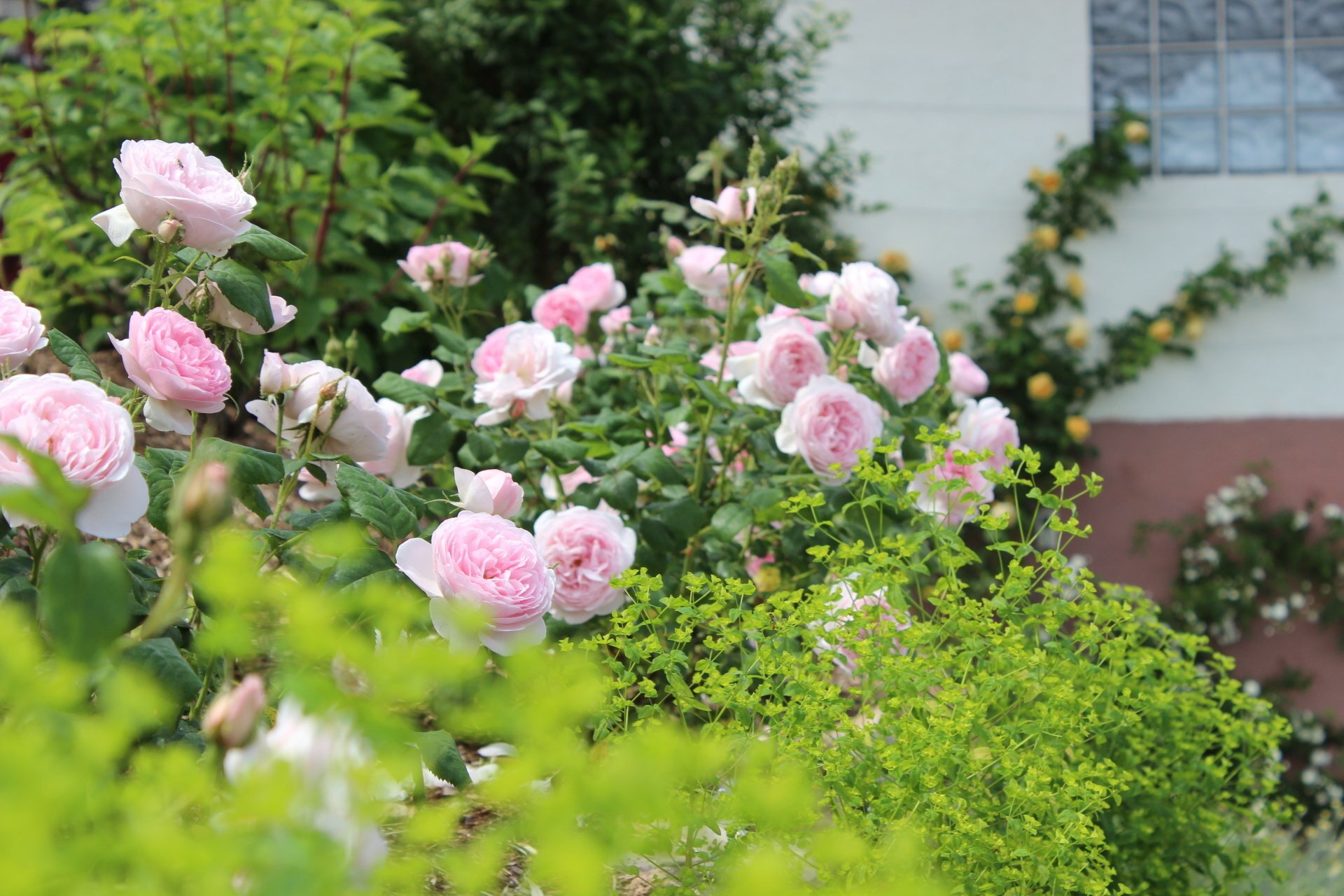Pruning English roses
Properly pruning roses – this is how they bloom more beautifully and stay healthy.
A targeted rose pruning is crucial for healthy growth, abundant bloom and a long service life Your roses. Whether in spring, summer or with old bushes – with the right pruning you promote vitality, abundant flowering and a harmonious growth form.
Spring pruning – the most important pruning in the rose year
The Spring pruning This occurs as soon as the Forsythia are in bloom – this is the most reliable sign that no more severe frosts are expected. Now:
- Bed roses Cut back to 3–5 strong shoots and 3–5 buds per shoot.
- Shrub roses lightly thinned and cut back to about 40–60 cm
- Climbing roses only slightly pruned; old, rotten wood can be removed.
- English Roses lightly to moderately pruned, depending on the variety and location
Important: Always diagonally above an outward-facing eye Cut – this way the rose grows nice and airy and outwards.
Summer pruning – for a second bloom
At the Summer cut are regularly Remove faded flowers and weak shootsThis saves energy and stimulates many varieties to produce more fruit. second bloom in late summer on. Also Suckers They should be removed from the rootstock immediately – they rob the prized variety of nutrients and space.
Rejuvenation pruning – bringing older roses back into shape
Old, overgrown rose bushes benefit from stronger pruning. Rejuvenation pruning in late winter or early spring. This involves:
- Remove very old, dead, or overly densely growing shoots close to the ground.
- Leave younger, vital shoots as the new basic structure.
- For heavily woody shrubs, cut back a maximum of 1/3 of the plant.
The result: New shoots, better ventilation and increased flowering power.
Pruning roses – the most important tips at a glance:
- Use sharp, clean rose shears, to create smooth cut surfaces
- Cut always above an outward-facing eye
- Remove diseased or dead wood completely
- Choose the right timeSpring for structure, summer for flowering, late winter for rejuvenation
- Don't be afraid of the cut – Roses tolerate pruning well and regenerate quickly.
Conclusion:
Regular, well-executed pruning strengthens your roses, promotes healthy new growth, and ensures a lush, long-lasting bloom – Year after year.
Instructions: How to prune roses correctly – step by step
1. Spring pruning (main pruning)
Time: If the Forsythia are in bloom (usually March–April)
Goal: Plant structure, promote vitality, remove dead wood
What to do:
- Remove dead and frozen wood
- Cut all shoots except for 3-5 buds (in the case of bed roses)
- Shrub roses shorten by 1/3 to 1/2
- Climbing roses Only thin out the plants, possibly remove old shoots.
- Always diagonally above an outward-facing eye cut
2. Summer pruning (maintenance pruning)
Time: After the first flowering, during the growing season (May–August)
Goal: Encourage second blooms, keep plant in shape
What to do:
- Cut off faded flower heads
- Remove weak or interfering shoots
- Suckers (mostly below the grafting point) Separate immediately
- Keep the plant well-ventilated, but do not prune it back too severely.
Rejuvenation pruning (radical pruning of old roses)
Time: Late winter to early spring (February–March)
Goal: Revitalize old, overgrown rose bushes
What to do:
- Remove old, thick, sparsely flowering wood close to the ground
- Lasse 2–3 vital main shoots stand
- Shorten remaining shoots 40–60 cm
- Remove all inward growing wood
- Only necessary every 3-5 years
Basic rules for all rose pruning
Always with
sharp, clean scissors
work
Diagonally above an outward-facing eye
cut
Do not prune in freezing conditions
No fear:
Roses are very forgiving!
Rose care – The best tips for healthy, floriferous roses
Anyone who wants to enjoy strong, floriferous and healthy roses in the long term should, in addition to pruning, also do a few other things. Care tips for roses Pay attention. Because with the right care, roses become true gems in the garden – from the first bud until late autumn.
1. How to water roses correctly
Roses need plenty of water, especially during hot and dry summer periods. Pay attention to the following points:
- Water deeply and thoroughly, instead of just superficially
- Ideally in the morning or evening, Do not water over the leaves. – this prevents fungal diseases
- Particularly Water new or freshly planted roses regularly.
2. Mulching – Protection for soil and plant
Mulching the rose bed protects the soil from drying out, retains moisture, and suppresses weeds. The following are recommended:
- bark humus, composted horse manure or Rose soil with straw
- In spring, approximately. 3–5 cm mulch layer Apply around the plant – but not directly on the trunk
- First fertilization in spring (March/April), as soon as the shoots grow
- Second fertilization after the first flowering (June/July) – e.g. with organic rose fertilizer
- Do not fertilize after that, in order to... Maturation before winter to support
- mildew, black spot or Rose rust – remove affected leaves early
- Aphids Treat with nettle tea or organic sprays
- Choose resistant varieties (e.g. ADR roses) and ensure good air circulation.
- Lightly mound soil around roses in the flower bed (approx. 10 cm with soil or compost)
- For standard roses: Protect the crown with jute or fleece.
- Lightly wrap or cover climbing roses on walls
3. Fertilize roses – for strong blooms and healthy growth
Roses are among the heavy feeders and require nutrients regularly:
4. Recognizing and preventing diseases and pests on roses
A healthy location is the best protection, but still check regularly for:
5. Regularly remove faded blooms
Through the Removing faded flower heads The rose doesn't invest energy in seed production, but instead forms new buds. This is how you promote... Second or continuous flowering many varieties.
6. Winter protection for roses
Especially in the first year or with sensitive varieties:
Conclusion:
With these simple but effective tips for Rose care Your roses will remain healthy, bloom profusely and be resilient – rewarding you with a lush display of flowers from spring to autumn.
More care tips
Roses should never be allowed to dry out. Therefore, even well-established, older rose bushes need additional water during hot, dry summers. It is important to water thoroughly so that the water reaches the deep roots and not just moisten the surface. Five liters of water is a good guideline for shrub roses. Avoid wetting the foliage when watering to prevent fungal diseases. Repeat-flowering roses should be fertilized twice a year: once at the beginning of new growth in late March and once after the first bloom in late June. Alternatively, a slow-release fertilizer can provide the plants with all the necessary nutrients.
Tips for combating pests and diseases
"Prevention is better than cure" – with appropriate planting and care measures, the risk of disease in English roses can be significantly reduced. Careful site selection lays the foundation for healthy roses. Varied plantings in the beds also promote an environment that attracts beneficial insects. Ladybugs and their larvae consume hundreds of aphids during their development; hoverfly larvae also reduce the aphid population. The larvae of the rose leaf-rolling sawfly can be removed by hand. Chemical agents should only be used in cases of severe infestation. Powdery mildew is characterized by a powdery white coating on leaves and flowers. Black spot causes violet-black spots on the leaves that radiate outwards in a star shape, leading to yellowing of the foliage and leaf drop. Rose rust, recognizable by orange to rust-colored spore masses on the undersides of leaves, also threatens English roses. There are a number of fungicides suitable for English roses to combat fungal diseases.













